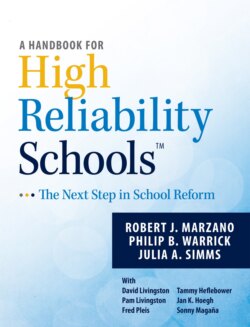Читать книгу A Handbook for High Reliability Schools - Robert J Marzano - Страница 13
На сайте Литреса книга снята с продажи.
Quick Conversations
ОглавлениеAs the name implies, quick conversations are brief discussions that occur between teachers charged with collecting quick data and various members of a school community. For example, questions such as “How safe has our school been lately?” might be designed around leading indicators 1.1 and 1.2, which deal with safety (see chapter 1). Similarly, questions could be designed for leading indicator 1.3, which deals with teachers’ having a voice in school decisions (see chapter 1), by asking, “Recently, to what extent have teachers had roles in making important decisions regarding the school?” One or more of these questions would be asked of teachers, students, and parents over a short interval of time (for example, during a specific week).
Members of collaborative teams within a PLC are perfect candidates for quick conversations. For example, consider a school that designs or selects (from the lists of questions in chapters 1 through 5) questions every month for each high reliability level it has already achieved. One or more members selected from a collaborative team are then invited to ask these questions of teachers, students, or community members (whichever groups are appropriate) and engage in five to ten quick conversations with appropriate members of the school community. These conversations last only a few minutes and occur with those school community members who are readily available. Immediately after each interaction, the teacher asking the questions codes each answer using a scale like the following:
Excellent—The answer indicates that the respondent believes the school is performing above what would normally be expected for this issue.
Adequate—The answer indicates that the respondent believes there are no major problems relative to this issue.
Unsatisfactory—The answer indicates that the respondent believes there are major problems that should be addressed relative to this issue.
The teacher asking the questions records the responses on a form such as that in figure I.2.
Figure I.2: Sample quick conversations response form.
Visit MarzanoResources.com/reproducibles/leadership to download a reproducible version of this form.
Notice that the collaborative team member who initiated the quick conversation has recorded the respondent’s role (teacher), the questions asked, the code assigned to each response (adequate for question 1, unsatisfactory for question 2), and any pertinent notes from the conversation.
At the end of the month, the team aggregates the responses, as depicted in figure I.3.
Figure I.3: Aggregated quick conversation responses.
Visual representations of data, such as those in figure I.3, allow school leaders to quickly identify problems, take steps to mitigate their effects, and resolve unsatisfactory situations. Here, school leaders might decide to reexamine the processes in place to collect information about teachers’ opinions. Additionally, graphs like these give members of the school community a quick look at areas where the school is excelling and allow for celebrations of success.
